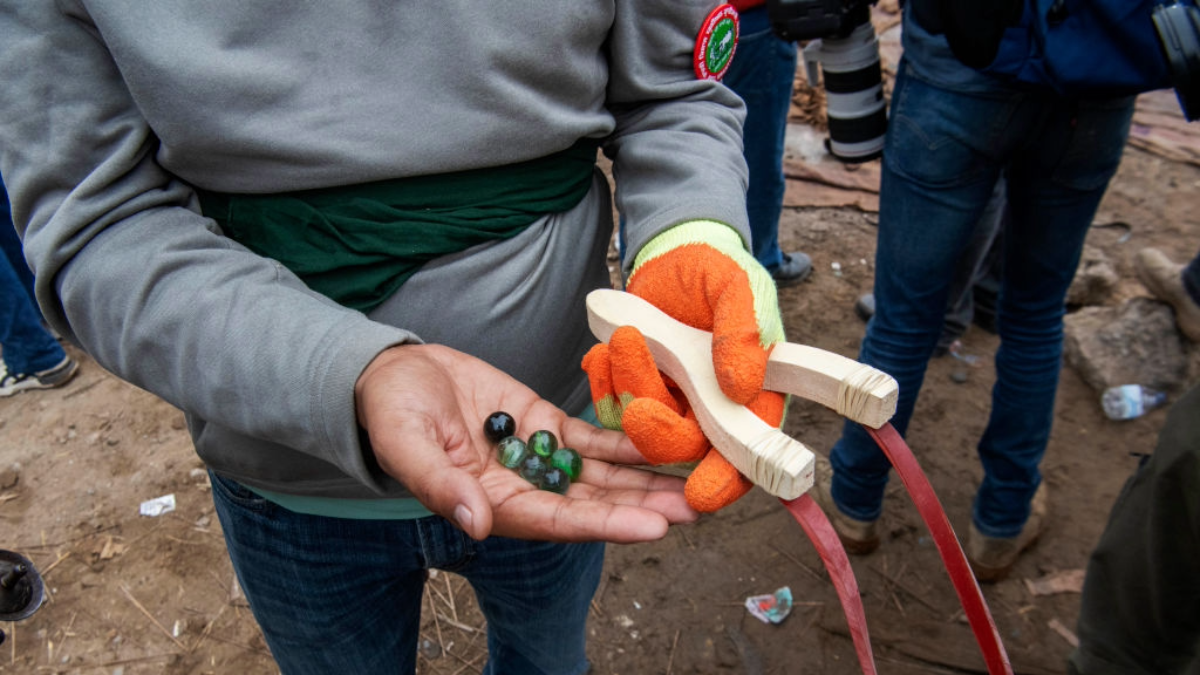India Clamps Down on Dissent with Drones
Rina Chandran / Mar 15, 2024
A man is using a slingshot to bring down a UAV drone that is firing tear gas shells at the protest site, while farmers are marching towards New Delhi to press for better crop prices that were promised to them in 2021. This took place at the Shambhu barrier, a border crossing between the Punjab and Haryana states in India, on February 21, 2024. (Photo by Rohit Lohia/NurPhoto via Getty Images)
The small village of Shambhu in western India may seem an unlikely staging ground for cutting-edge surveillance technology. Yet it is here that an arsenal of new technologies has been unleashed on thousands of farmers attempting to march to the national capital, Delhi.
The farmers – who are demanding better prices for their crops – are dealing with surveillance drones firing teargas shells, facial recognition systems, and having their phones tracked, in addition to internet shutdowns and seeing their accounts on X suspended to keep them from communicating.
While facial recognition technology is everywhere in India – from airports to prisons – and has been used at previous protests and rallies, civil rights groups say it is the first time that surveillance drones have been used to fire teargas shells at civilians.
RELATED: The Landscape of Facial Recognition Technologies in India
The drones were developed by the federal government’s Border Security Force, which hailed it as "a potential force multiplier to the security forces in law-and-order management."
Bhavjit Singh, a supporter of the farmers' protest, said that in Shambhu – which is in Punjab state near the border with Haryana state – "it's like being in a war zone."
"These are tactics that you would expect to be used against enemies of the state,” Singh told me. “Not on unarmed citizens who are simply exercising their right to free speech and to protest peacefully," said Singh, who is playing a cat-and-mouse game with authorities, creating new X accounts to broadcast images and videos from the protest as quickly as they are taken down.
Local media and digital rights groups have recorded an uptick in demand for drones by Indian law enforcement agencies that use them for policing and surveillance over the last few years – despite there being no law to regulate their use by the police.
There is also no transparency on what data is being collected, and how it's being used.
"The manner in which Haryana police is using drones during the protests is unregulated and not backed by proper legal procedure, is disproportionate in nature, and unconstitutional," digital rights advocacy Internet Freedom Foundation said in a letter to state authorities.
These actions are also in a regulatory vacuum, as the Drone Rules (2021) are largely about regulating private entities using unmanned aerial vehicles for research and development purposes, and "do not prescribe any standards or limitations for their use by government agencies," IFF noted.
Not that the lack of clear laws has stopped authorities in India from spying on its 1.4 billion citizens. And the world's most populous nation is also the top offender when it comes to internet shutdowns, accounting for more than half of all documented shutdowns globally since 2016.
Indian cities including Indore, Delhi, Hyderabad and Bengaluru are among the most surveilled in the world, as measured by the number of CCTV cameras per 1,000 people. There have already been several cases of misidentification, largely of those belonging to minority religious and ethnic communities.
In Shambhu, some protesters allegedly "involved in violence" have been identified with CCTV cameras and drone cameras, and will have their passports and visas cancelled, a police official said.
Some protesters are being informed that their phones are being tracked, and that any damage to public property – including to metal barricades – will be recovered by seizing their properties and freezing their bank accounts. Authorities are also known to track mobile phone locations of activists and journalists at protests, including those against a citizenship law and the previous farmers’ protest.
Spyware has been used in India to track journalists, activists, lawyers and opposition party politicians, with nearly two dozen people being informed by Apple as recently as last November that they had been targeted by "state-sponsored" hackers trying to remotely access their iPhones.
Most of those targeted were opposition politicians, and the warning comes just ahead of a national election that must be held by May. The Indian government has denied allegations that it is spying on its citizens, and officials said that they were investigating the complaints of phone hacking.
While Apple did not name the government involved or the type of spyware used, at least one victim's phone was hacked with the Israeli firm NSO's Pegasus, which was also used in a series of hacks in 2021.
Indian authorities have repeatedly declined to confirm whether the government bought Pegasus, saying only that "unauthorised surveillance does not occur."
But for Antony Lowenstein, author of The Palestine Laboratory, the connection is obvious: Israel is a model for nations like India that want to use technology to track and control dissenting populations.
Just as Israel treated Palestine as its testing ground for surveillance technologies, so too does India in Kashmir and the restive northeast, as well as at any mass protests, Lowenstein told me days after the Oct. 7, 2023 attacks by Hamas that triggered the massive, ongoing response from Israel.
"The Israel model has been embraced by India, and that includes constant surveillance of dissenters and minority communities, cutting their access to the internet, monitoring their social media activity, and punishing them for their dissent," he said.
With Indian Prime Minister Narendra Modi and his Hindu nationalist Bharatiya Janata Party widely forecast to win a third straight term, "we will see a greater validation of surveillance technology, and a massive increase in the use of surveillance technology in India," he said.
That does not bode well for those trying to hold the government to account in India. And the protesting farmers in Shambhu may find their low-tech defenses – kites and sling shots – ineffective.
Authors
